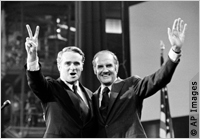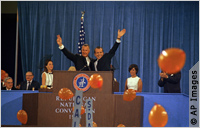U.S. GOVERNMENT | A resilient balance of institutions
11 July 2008
Process of Selecting Vice President Evolved over Centuries
America’s earliest running mates often competitors rather than partners

Washington -- Imagine if in the 2008 elections, Americans selected a Democratic president and a Republican vice president.
With top executives from two different parties, it could be difficult for the White House to present a unified message and political battles could slow progress. The Founders learned this after watching the process unfold.
Originally, the candidate who finished second in Electoral College votes was named vice president. The Founding Fathers seem to have believed this would ensure a credible, well-liked vice president and perhaps help provide for an orderly succession.
But the framers of the Constitution did not anticipate the creation of political parties. In 1796, Federalist John Adams became president and Thomas Jefferson of the Democrat-Republican party won the vice presidency. In office, Jefferson saw his role to be that of an opposition leader and spent much of his time planning his campaign against Adams in the next election.
In the 1800 election, Jefferson and his running mate Aaron Burr were of the same political party. However, Burr and Jefferson each had received the same number of Electoral College votes, and Electoral College rules state that the House of Representatives votes to break a tie. Burr decided he would seek the presidency rather than the vice presidency, creating animosity between the two as the House of Representatives voted more than 30 times before selecting Jefferson as the winner.
One of the few constitutional duties of the vice president is to cast a tie-breaking vote in the Senate. Angry with Jefferson, Burr cast tie-breaking votes that went against the president’s wishes.
To avoid these types of problems in the future, Jefferson led the effort to pass the 12th Amendment to the U.S. Constitution in 1804. It required presidential and vice presidential candidates to run together on a ticket. The amendment also specified the qualifications for vice president, which are the same as for president: a natural-born U.S. citizen, at least 35 years old, with at least 14 years of residency in the United States. Additionally, the presidential and vice presidential candidates cannot be from the same state.

Forming tickets became tricky political business. As party leaders met at conventions to nominate their candidates, leaders realized they could please party members by selecting a presidential nominee from one faction of the party and a vice presidential nominee from another. As a result, nominees often disagreed and vice presidents typically were relegated to minor roles. They also often were replaced when the president sought re-election.
20TH-CENTURY CHANGES
The modern era of selecting vice presidents began in 1940, when President Franklin D. Roosevelt refused to run for a third term unless Vice President John Nance Garner was replaced with Secretary of Agriculture Henry Wallace. Party leaders agreed, nominating and voting for Wallace at the Democratic National Convention.
Only once since then has a presidential nominee left the decision on the vice presidential candidate to the national party convention. In 1956, Democratic candidate Adlai Stevenson let delegates decide between Senators Estes Kefauver and John F. Kennedy. Although Kefauver won, Kennedy gained valuable exposure that helped him win the presidency four years later.
Today, it is the presidential nominee’s decision to select a running mate with whom he is personally comfortable. Party leaders try to influence the choice by suggesting candidates who will help balance the ticket by bringing in voters from different regions of the country or of different ideological backgrounds. Initially, candidates like Republican Dwight Eisenhower in 1952 let party leaders provide a list of appropriate candidates from which he made his final selection.
After 1952, candidates tended to pick their running mates themselves, quietly inviting potential vice presidential nominees over for informal discussions and picking the person with whom they felt most comfortable. In 1968, Republican candidate Richard Nixon let his stunned staff know of his decision to ask Maryland Governor Spiro Agnew to be his running mate just minutes before making his announcement to the country.
Giving a presidential candidate sole discretion to select a running mate has led to some setbacks. In 1972, for example, Democrat George McGovern selected Senator Thomas Eagleton, only to learn after his announcement that Eagleton had undergone electroshock therapy treatment for depression. Two weeks later, Eagleton was taken off the ticket.
To avoid similar scenarios, presidential candidates Barack Obama and John McCain will get help from a team that develops a list of candidates, conducts preliminary interviews and completes exhaustive background checks to identify weaknesses that could hurt the campaign.
See also "Vice Presidential Candidate a Political and Personal Decision."
